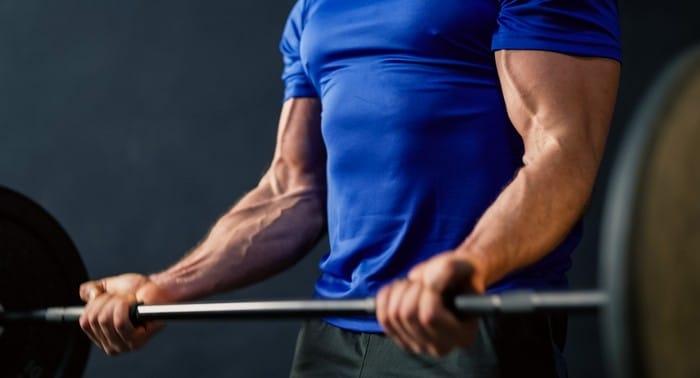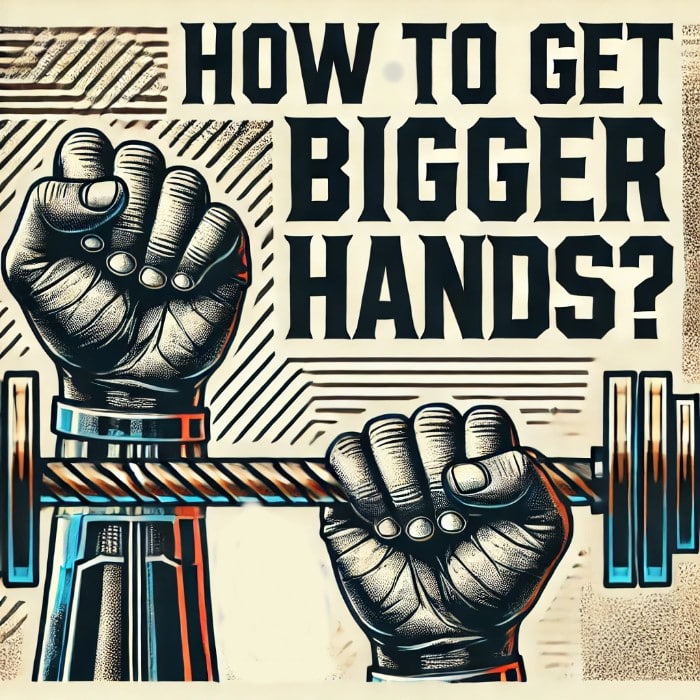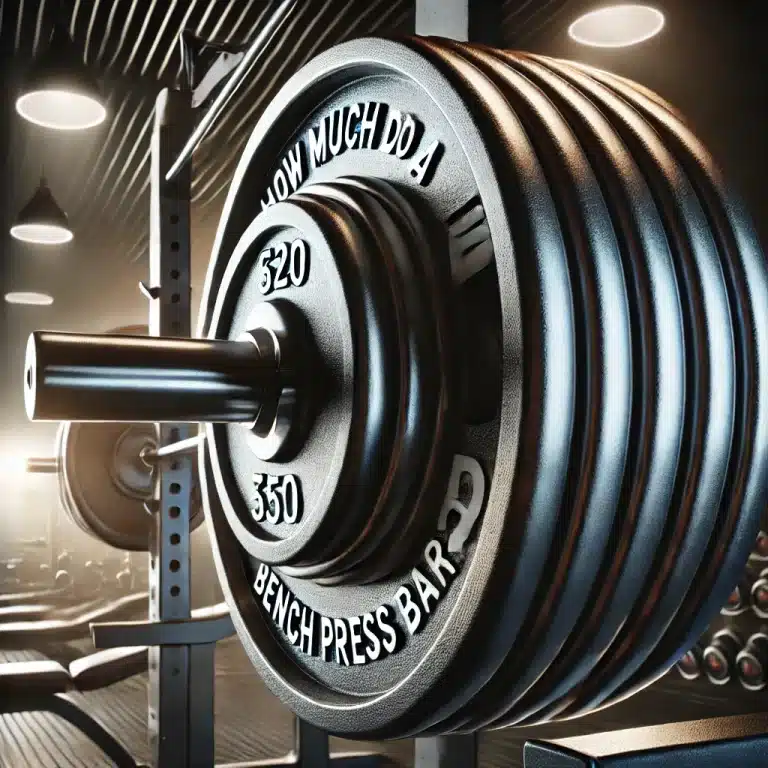The Best Deadlifting Shoes 2024 Edition
If you’re looking for the ultimate test of strength, and indeed, the ultimate indicator of strength, then you need to be doing deadlifts.
That’s handy because today we’re looking at deadlifting shoes in a great deal of detail.
The deadlift is one of the most effective compound exercises in the world today.
It works your back, your traps, your quads, your hamstrings, your core, and your grip strength too, and it is a great accessory exercise for a whole host of other exercises too.
If you’re looking to squat more weight, for example, deadlifts are ideal. If you’re looking to become a better presser, deadlifts are great.
If you want to improve your grip strength, yep, deadlifts have got your back. Literally.
To deadlift safely and efficiently, however, you not only need to execute the perfect form, but you also need the right kit and equipment.
A typical deadlift kit includes things like straps, belts, and deadlifting suits. While some people wear deadlifting socks or lift barefoot, however, deadlifting shoes should also be added to your list.
Deadlifting shoes come in a variety of styles and designs and offer a wide range of different benefits. Finding the right shoes, however, is difficult.
To make life easier in the gym, here’s a look at deadlifting shoes, along with the best deadlifting shoes for 2024.
What Are Deadlifting Shoes?
Deadlifting shoes, also known as deadlift shoes are designed specifically to be worn during one exercise.
Can you guess what that exercise is?
Yes, it’s the bench press. Only kidding, they are of course designed to be worn when deadlifting.
These are not just generic gym shoes or running shoes repackaged and branded as deadlift shoes, they are a very unique type of shoe that is designed to make you a safer and more efficient deadlift!
Deadlift shoes are designed in such a way that they allow you to get closer to the ground when you deadlift.
This reduces the distance that the bar has to travel.
Deadlift shoes feature a hardened, flat sole with a 0mm heel-to-toe lift.
The flat soles of the shoes mean that the deadlifter’s soles are in closer proximity to the floor, which in turn means that they become more stable and secure, and have less distance to pull the weight.
This, in turn, means that they become better deadlifters and can lift more weight, with better form.
While we can’t guarantee that wearing deadlifting shoes will help you to deadlift more than a prime Eddie ‘The Beast’ Hall, we can guarantee that your deadlift sessions will improve noticeably thanks to the shoes.
What Are The Benefits Of Deadlifting Shoes?
If you’re looking for ways of taking your back workouts, and indeed, your leg workouts, to a whole new level entirely, then deadlifting shoes must be one of your top priorities.
Anybody who tries to tell you that shoes are shoes is lying through their teeth as deadlift shoes are like no other shoes ever created.
Just as you have golf shoes designed to be used on a golf course, and running shoes designed to be worn when running, deadlifting shoes are designed to be worn when deadlifting.
But what is it about deadlift shoes that makes them so special?
Check out these benefits of deadlifting shoes and all will soon become clear.
Deadlift Shoes Offer Arch Support
One of the most common misconceptions surrounding deadlift shoes is the fact that because they have flat soles (more on that later) they do not provide arch support.
This is complete nonsense.
Because of the unique design of deadlift shoes, they provide a very slightly raised arch rather than padding, along with a metatarsal strap.
Together, these provide heaps of support for your arches and can improve posture while maximizing comfort in the process.
Because of this design, the strap will help pull the shoe tight while the shoe prevents instability and helps to support the arches to prevent pain or discomfort.
The strap for the metatarsal will also pull the shoe as close to the ground as possible.
Deadlift Shoes Support The Ankles
Another huge benefit of wearing deadlift shoes is the fact that they also support your ankles.
When you’re pulling a heavy weight from the floor, the last thing that you want is to lose your footing and twist or even break your ankle.
That could be disastrous, which is why deadlifting shoes are so beneficial.
Different deadlift shoes come in different designs but if it’s ankle support that you’re looking for, look for high-top design shoes with a high collar and a metatarsal strap.
These will not only help to keep you stable for the duration of the lift, but they will also ensure that your ankles have plenty of support.
The best thing about having deadlift shoes with a strap is the fact that you can tighten them manually so you can increase or reduce the amount of support your ankles receive in a matter of seconds.
Deadlifting Shoes Reduce Your Risk Of Injury
When you deadlift, it doesn’t matter whether you’re pulling 135 pounds or 700 pounds, you must ensure that you execute the lift with perfect form. Failure to do so could put you at an increased risk of injury, and nobody wants that.
When people hurt themselves deadlifting, oftentimes they do so because of improper foot placement, or because their foot slipped halfway through the lift.
A deadlift injury to your legs, back, or even your biceps, could be debilitating which is why it’s so important to be safe.
Deadlifting shoes help you to be safe for the duration of the exercise as they not only support the feet but also help to grip the floor and keep your feet and legs anchored in place.
The fact that they keep you so stable is important because it means that you can just focus on pulling the weight, rather than trying to get your balance and regain your footing halfway through the lift.
Less Range Of Motion
Deadlifts are one of the few exercises out there where less range of motion is more beneficial. This is another reason why deadlift shoes are so popular.
The closer you are to the floor, the closer you are to the bar.
This means that the bar has less distance to travel before you can lock out the lift.
This makes the exercise slightly easier, and as you know, deadlifts are incredibly hard, especially if you have poor grip strength.
With deadlift shoes on, as your feet are flat the soles of your feet come into closer contact with the floor, so the bar has less of a vertical distance to travel when you grab it.
Even though we’re only talking about maybe an inch or two, that inch or two could be the difference between locking out a lift, or failing.
Deadlifting Shoes Keep You Stable
We’ve mentioned it several times already, but now let’s look at it in more detail and start talking about how deadlift shoes can keep you stable while deadlifting.
Deadlift shoes have flat soles.
Very simply, if you try to balance something flat on a flat surface, it is going to be much more stable and secure than trying to balance something with an arch.
Think of that when you consider the soles of your feet as you deadlift.
A typical running shoe or sneaker is crammed full of padding and cushioning, which, while feeling somewhat comfortable, is not the best when it comes to stability.
The padding on the soles alone could lift your feet off the ground by as much as an inch.
Furthermore, the rear sole is higher so your heel is higher, which creates a heel arch.
Having an elevated heel may be good for explosive movements, I.E running, but for deadlifting?
Not so much.
When you’re pulling hundreds of pounds up off of the ground you need to ensure that you are stable, secure, and stationary.
The cushioning and the lifted heel of a regular sneaker will leave you less stable on your feet, meaning you’ll struggle with the weight, plus you’ll be in greater danger of injury.
Deadlift shoes anchor to the floor more efficiently, plus they provide ankle support and arch support, so when you pull the weight you really won’t be going anywhere, and neither will the bar, other than up hopefully.
Deadlift Shoes Look Cool
Okay, the fact that deadlifting shoes look so cool might not technically allow you to lift more weight, but considering the shoes look cool, your ego will benefit.
Deadlifting shoes come in a variety of different styles, designs, brands, colors, and sizes and it’s safe to say that there are some pretty freaking amazing styles out there.
While having ‘drip’ might not help you to deadlift more in a conventional sense if it boosts your confidence and your mood, you’ll likely be in a better frame of mind before you deadlift, which could be all the difference.
Deadlifting Shoes Will Help You To Deadlift More
Again, we can’t promise that you’ll pull 501 KG like Thor ‘The Mountain’ Bjornsson’ or sumo deadlift like Jamal Browner, by wearing deadlift shoes, but what we can say with certainty, is that you’ll get better results.
Deadlift shoes are designed to be worn when you deadlift.
They aren’t some fancy gimmick or some Z-list celebrity-endorsed product on TikTok or Instagram, they’re the real deal and have been the real deal for decades.
Deadlift shoes are designed not only to keep you safe as you execute the lift, but they’re also designed to help make it easier for you to lift the bar off the ground, lock it out, and effectively perform a deadlift.
No matter whether you’re going for a 1 rep max, or if you’re deadlifting for reps, wearing deadlift shoes will certainly make you a better deadlifter.
Pretty cool, right?
Are Deadlifting Shoes Better Than Going Barefoot?
Check out any fitness “influencer’s” social media posts when it comes to deadlifting and you’ll likely see them training heavy, making way too much noise, getting chalk everywhere, and slamming down the weight when they’re done. You’ll also notice on their feet that a lot of the time, they’re barefoot.
While there’s nothing wrong with getting hyped up in the gym if you are showing off and doing it for ‘clout’ online, you put yourself at risk of injury, and nobody wants that.
Lifting weights while barefoot may offer some benefits, but ultimately it is a very risky strategy.
If you are deadlifting and you are wearing regular sneakers or running shoes, going barefoot for deadlifts can be beneficial, as long as you’re careful.
If given the choice between bare feet or wearing deadlifting shoes, though, the shoes should win every single time.
The only real benefit of deadlifting barefoot is the fact that your feet are closer to the ground, though unless you’re flat-footed, you’ll still have a bit of an arch.
The downside compared with deadlifting shoes is the fact that you have no arch support, no ankle support, no grippy soles, and no completely flat soles either.
On top of that, if you stub your toe, or worse still, drop a plate on your bare feet, you’re going to feel it a heck of a lot more than you would if you were wearing deadlifting shoes.
What To Look For In Deadlifting Shoes?
Don’t worry, before we wrap things up today, we’ll be looking at some of the most popular deadlifting shoes on the market today.
Before we do that, however, let’s first look at a few things you should look for when choosing deadlifting shoes yourself.
The Thickness Of The Soles
One of the most important things to consider when it comes to deadlifting shoes is the thickness of the soles.
Different shoes have different sole thicknesses, and different sizes can affect how the shoes feel and perform in a whole host of different ways.
If the sole is too thin you may not be stable enough. If the sole is too thick and you may struggle to find your balance and stabilize yourself properly.
Ideally, you want a deadlift shoe with a sole thickness of around 4 – 5mm, such as the SABO deadlifting shoes which we’ll look at later.
Just be aware, however, that there are some options out there with a thicker sole, up to 10mm in fact, that still do the job with a bit of tweaking here and there.
Generally speaking, though, 5mm is your magic number.
Thin And Flat
Another very important thing to consider, two things in fact, are the thickness of the shoes and the size of the soles.
Deadlift shoes should not feature a raised heel, nor should they be thick and clunky. If they are, they’ll feel heavy on your feet, and you don’t want that.
The sole should be thin so it allows you to make effective contact with the ground, and there shouldn’t be any cushioning.
Cushioning is for running, with deadlifts you’re stationary, so it will be detrimental to the exercise itself.
Hard And Resistant Outsole
The outsole of the deadlift shoes is just as important as the sole itself, which is why you need to find shoes with the correct type of outsole.
The outsole of your shoes should not be thin or soft, it should be hard and resistant.
The harder the outsole is, the better your foundation will be for performing the deadlift.
If the outsole was thick and soft, you’d be less stable on your feet, which is the last thing any deadlifted needs.
Wide Toe Box
Of course, this will depend on the size of your feet, but when you’re shopping around for a new pair of deadlifting shoes, make sure you choose a pair with a wide-toe box.
Deadlifting shoes with a wide toe box are important not only for comfort but also for practical reasons too.
When you deadlift you may need to spread your toes out slightly to help you get your balance, and if they’re all bunched up and cramped inside the shoes, this will prevent you from doing so.
We aren’t saying you should choose the next size up, but we are saying you will need to ensure you can move your toes around slightly when wearing the shoes.
If you can’t and your toes are squeezed too tightly together, the toe box is too small so try to find something a little bigger.
Plenty Of Ankle Support
When we were listing the many benefits of deadlifting shoes a little earlier in our article, we mentioned how deadlifting shoes provide ankle support.
Some, however, provide more than others.
If you’re dealing with joint issues, have injured your ankle in the past, or simply want to take better care of your ankles and joints, look for deadlifting shoes that provide plenty of ankle support.
High-top shoes such as the Converse Chuck Taylors are great here because they come higher up your foot and over the ankle, helping to provide more support and prevent it from moving as you perform the lift.
Plenty Of Grips
One of the main reasons why Converse and Vans are so popular amongst deadlifters, other than the flat sole of course, is the fact that the soles themselves are made from rubber and are therefore slip resistant.
When you’re lifting up a heavy barbell loaded with hundreds of pounds, the last thing you want is to lose your footing and slip.
If you’re lucky you’ll fail the lift. If you’re unlucky, however, you could suffer an incredibly serious injury that could leave you sidelined for months, or worse still.
When you see a pair of deadlifting shoes you like, check out the soles on them and see what the grip is like. Ideally, you should try them on different surfaces, I.E a deadlift platform, carpet, and gym mats.
Remember, gyms also get sweaty and slippery, so see how they hold up in damp conditions as well.
An Efficient Closure Mechanism
Another thing to look out for when you’re shopping for deadlifting shoes is a working and efficient closure mechanism.
When you’re deadlifting, the last thing you want when you’ve got the bar halfway in the air is your shoes coming undone.
This is where it pays dividends to have an efficient, working, closure mechanism.
Of course, there are plenty of great choices for deadlift shoes that come with laces, but if laces aren’t for you, make sure that the closure mechanism works effectively.
The Top 4 Deadlifting Shoes On The Market Today
2023 has seen a huge breakout of deadlifting shoes, and gym apparel in general for that matter, meaning there are plenty of options out there.
If you’re looking to take your deadlifting to a whole other level, while simultaneously being healthier and safer in the process, finding the correct shoes for deadlifting is essential.
This is where we enter the fold.
To help you find your dream pair of deadlifting shoes, here’s a look at 4 of the best deadlifting shoes currently on the market.
Converse Chuck Taylor All-Star High Tops

We’ve mentioned Converse for lifting a few times today, and when it comes to deadlifting shoes that are not deadlifting shoes, Chuck Taylor All-Star High Tops take some beating.
These are worn by thousands of lifters all over the globe, and despite being designed exclusively for basketball, it turns out that they work incredibly well as deadlifting shoes.
They also look great and are very fashionable too, which is even better.
PROS
-
Flat sole with a 0mm heel-to-toe drop
-
Comfortable
-
Easy to adjust
-
Rubber sole for extra grip and traction
-
High collar to provide adequate amounts of ankle support
Cons
-
Thick sole at 10mm thick, though you can remove some insoles to reduce this to around 6mm.
-
Not the best traction on some surfaces
-
Slight compression under especially heavy loads
-
No arch support
Vans SK8 HI

Of course, we can’t talk about Converse, without talking about Vans for lifting.
Vans are to Converse, what Xbox is to PlayStation, or Samsung is to Apple.
VANS SK8 HI shoes are another pair of high tops that were not created solely for deadlifting, but instead for skating.
Despite this, though, they’re fantastic for deadlifting and do a good job.
Vans feature a classic rubber waffle outsole, thin material, a decent grip and traction, and ankle support, all along with a 0mm heel-to-toe drop, giving you that flat sole required for deadlifting some heavyweight.
Pros
-
Very affordable at less than $60
-
Stylish and attractive design
-
Ankle support
-
0mm heel-to-toe drop
-
Grippy rubber waffle sole
Cons
-
Not much of a toe box
-
Can feel a little tight
SABO Deadlift Shoes
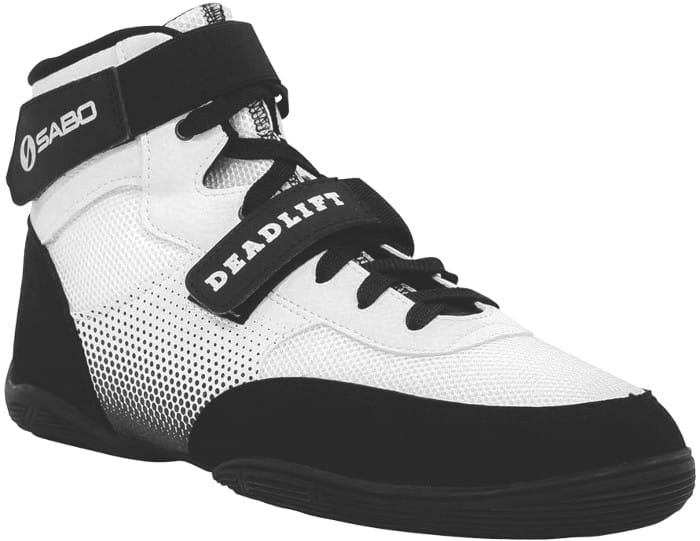
When you talk about premium deadlifting shoes, SABO Deadlift Shoes have to be in the conversation.
If you imagine SABO Deadlift Shoes as the Concept 2 Rower of the rowing world, that gives you a pretty clear indication of just how effective these shoes are.
SABO Deadlift Shoes are considered by many to be the best deadlift shoes ever created.
They’re flat, they’re made from premium quality materials, they have a metatarsal strap, they feature an ankle strap, they’re comfortable, and they look fantastic as well.
Pros
-
Completely flat 0mm heel-to-toe drop
-
Ankle support
-
Metatarsal strap support
-
Slight arch support
-
Fantastic grip and traction
-
Sleek and cool design
-
Thin and dense sole which does not compress
-
Plenty of toe box space
-
Amazing feel on the feet
-
Multiple color combinations to choose from
Cons
-
Can be a little expensive
-
Heel fabric may compress and wear down over time
Nike Romaleos 4
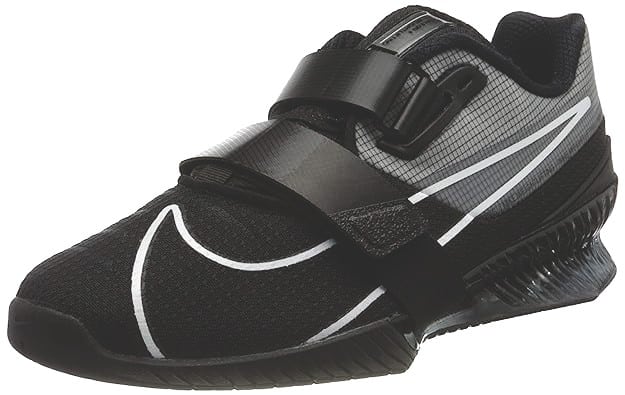
Nike is a brand that is synonymous with sportswear and when it comes to deadlifting, the Nike Romaleos 4 could be a game-changer.
This shoe is not only beneficial for people performing deadlifts, it’s also great for people to wear when doing other Olympic-style lifts, or powerlifting exercises such as bench presses or squats.
These shoes offer plenty of traction and foot support, though the main concern is the 20mm heel-to-toe drop, which is far from ideal for deadlifts. Still, it’s certainly better than running shoes or sneakers.
Pros
-
Classic Nike design
-
A versatile shoe that’s great for weightlifting
-
Amazing traction and grip from the soles
-
Wide toe box
-
Very comfortable
Cons
-
The main drawback is the fact that they’re not fully flat, thanks to the 20mm heel-to-toe drop. This means they’re not the best for deadlifts
-
Thin breathable material may not be very durable.
Final Thoughts
Okay, so, that brings this look at deadlifting shoes to a close.
So, what did we learn?
Well, we learned that having a flat sole and plenty of grip, along with ankle and arch support is very important for deadlifting shoes.
We also learned that Converse and Vans make great options, despite not being designed for deadlifting, and if you plan on Olympic lifting as well, Nike could be the brand to go with.
Ultimately, however, there is only one winner, and that is the SABO Deadlift shoe.
If your budget allows it, this deadlift shoe will last you for years and will not let you down.


